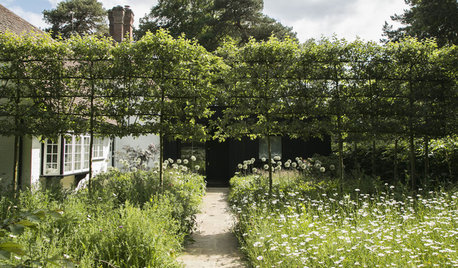Planting apple trees
ich_bin_nathan
16 years ago
Related Stories

EDIBLE GARDENSHow to Add an Apple Tree to Your Edible Garden
Readily available, beautiful and fragrant, apple trees offer four-season interest along with crisp, juicy fruit
Full Story
GARDENING AND LANDSCAPINGCrab Apple Trees Set Off a Stylish English Courtyard
A structure of pleached crab apple trees, bordered by a wildflower meadow, links a minimalist addition to an old house in Buckinghamshire
Full Story
GARDENING GUIDESPlant Black Cherry Trees for the Birds and Bees
Plant Prunus serotina in the Central and Eastern U.S. for spring flowers, interesting bark and beautiful fall color
Full Story
ARBOR DAY8 Reasons to Plant a Great Tree
Beauty is its own reward, but the benefits of planting the right tree in the right place go way beyond looks
Full Story
TREES7 Deer-Resistant Flowering Trees to Plant this Fall
If you live in a neighborhood with roaming deer, consider these beautiful trees that won't tempt hungry guests
Full Story
GARDENING GUIDES10 Top California Native Plants, Trees and Grasses
Enjoy a fuss-free, water-wise garden in the Golden State by growing plants naturally in tune with the climate and wildlife
Full Story
GARDENING AND LANDSCAPINGCrazy for Fruit Trees
Whether a single citrus or a mini apple orchard, even the smallest landscape space can bear deliriously delicious fruit
Full Story
FALL GARDENINGWhy Fall Is the Best Time for Planting
Spring is overrated for planting. Starting plants in autumn has advantages for both garden and gardener
Full Story
EDIBLE GARDENSHow to Grow 10 Favorite Fruit Trees at Home
Plant a mini orchard in fall, winter or early spring to enjoy fresh-off-the-tree fruit the following year
Full Story
FALL GARDENING6 Trees You'll Fall For
Don’t put down that spade! Autumn is the perfect time for planting these trees
Full StorySponsored






heleninramsey
leaveswave
Related Professionals
Wareham Landscape Architects & Landscape Designers · Avocado Heights Landscape Contractors · Alpharetta Landscape Contractors · Arden-Arcade Landscape Contractors · East Lake-Orient Park Landscape Contractors · Fort Myers Landscape Contractors · Middle River Landscape Contractors · Middletown Landscape Contractors · North Plainfield Landscape Contractors · Pahrump Landscape Contractors · Parker Landscape Contractors · Reedley Landscape Contractors · Wanaque Landscape Contractors · Waterford Landscape Contractors · Hawaiian Gardens Landscape Contractorsich_bin_nathanOriginal Author
sjmarq
leftwood
Julie
loodean
leftwood
Julie
leftwood
Julie
leftwood
ich_bin_nathanOriginal Author
leftwood
Julie